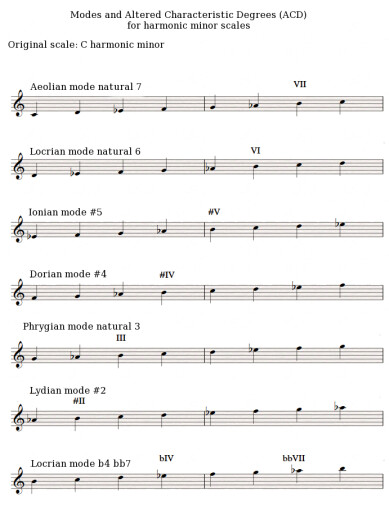In the previous article we made a brief pause in the study of the characteristics of the different modes to introduce two particularly useful forms of writing in the modal system: the pedal and the ostinato.

Today we’ll go back to the theory. And I’ll start this new stage with a question. Can you create modes from a minor scale? The answer is: yes!
And I have a second question for you: Can you create modes from all types of minor scales? The answers is, again: yes!
One last question – drum roll, please! Can you create modes form other types of minor scales? The answer is once again: yes!
And a spoiler: all in all you get 28 modes this way. But we will come back to this later…
Brief reminder of minor scales
Let’s quickly go through all the minor scales there are: There’s the natural minor scale, the harmonic minor scale and the melodic minor scale. If you want to go through the details of each of theses scales, I invite you to go back to article 2 of this series.
The case of the natural minor scale
We won’t review the modes of the natural minor scale, because it is basically the Aeolian mode of the major scale it corresponds to (its relative major), so the modes of this minor scale are the same as those of the relative major scale.
The modes of the melodic minor scale
How come I mention the melodic minor before the harmonic minor, you ask? There’s a good reason for that. The minor melodic scale has only one alteration in relation to the major scale, the third. So the modes of this scale will only differ in one alteration with those of the major scale.
In article 2 of this series you saw that the tonal system doesn’t accept the melodic minor scale unless it’s in ascending order, because in descending order it is replaced by the natural minor scale. In the modal system, this principle is abandoned: the modes based on the melodic minor scale stay the same both upwards and downwards.
The natural modes of the major scale distinguish themselves due to their Natural Characteristic Degrees (NCD). The altered modes from the minor scales distinguish themselves by their… Altered Characteristic Degrees (DCA)!

- MinMel 01 ionien bemol 3 00:07
- MinMel 02 phrygien becarre 6 00:07
- MinMel 03 lydien diese 5 00:07
- MinMel 04 lydien bemol 7 00:07
- MinMel 05 mixolydien bemol 6 00:07
- MinMel 06 locrien becarre 2 00:07
- MinMel 07 locrien bemol 4 00:07
The modes of the harmonic minor scale
To finish this quick overview of altered modes, here are the modes from the harmonic minor scale. Do note that the first degree is not Ionian but Aeolian.

- MinHarm 01 Eolien becarre 7 00:07
- MinHarm 02 locrien becarre 6 00:07
- MinHarm 03 ionien diese 5 00:07
- MinHarm 04 dorien diese 4 00:07
- MinHarm 05 phrygien becarre 3 00:07
- MinHarm 06 lydien diese 2 00:07
- MinHarm 07 locrien bemol 4 double bemol 7 00:07


